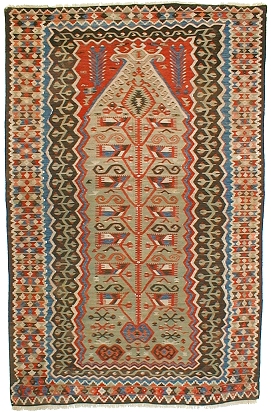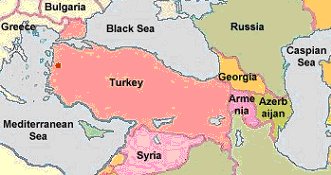
|
|

 |
|
Origin: Aydin / Kula
Western Anatolia
Woven: c. 1880
Size: 1.74 x 1.11 m 5'8" x 3'6"
Ref: 400NB002
Price Euros 3600
This prayer kilim shows design and colour combinations typical of both Aydin and Kula, towns lying about 120 km from each other in what is now modern Western Turkey. It is likely that the weaver was familiar with the techniques from both towns, probably through marriage. The central mihrab (prayer arch) contains a very stylized tree of life design typical of this area, surrounded by the customary vine pattern and then a repeated geometric design as an outside border. As well as the colours being particularly pleasing on this piece, the design of the outside border is extremely unusual, is very rarely seen on prayer kilims of this type and therefore sets it apart. It was important in a prayer rug where motifs were placed, in particular, the seven points of contact of the user with the rug. According to Anatolian Folkloric belief, it was thought that the motifs used could therefore have magical significance. The weaver of this kilim has used a complex rams horn motif at the apex, thought to signify heroism, power and masculinity. This would have been the point of contact of the forehead. Similarly there are other motifs positioned where the hands, knees and toes would be in contact with the ground when the rug was used in prayer. Some extra motifs indicate the weaver's wish that no harm might come to the user, and this was particularly true of prayer rugs. The weaver here has also made many random improvisations within the central mihrab that add to the character of this fine antique kilim.